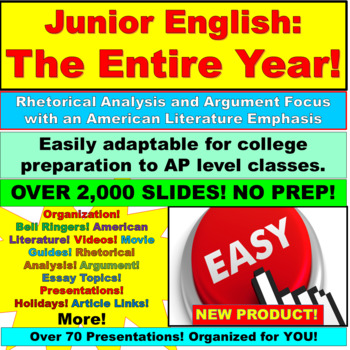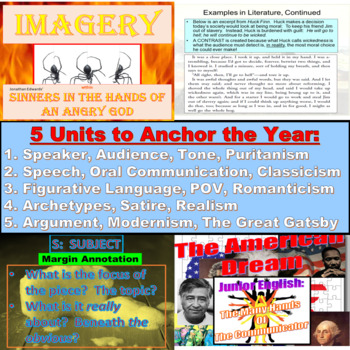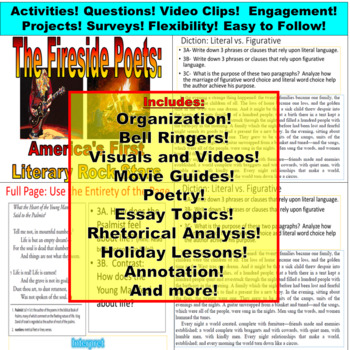11th Grade English Entire Year: Complete, Full Junior Year, American Literature
- Zip
- Google Apps™

Description
Perfect for in-class instruction OR distance learning! Your JUNIOR, 11th grade year curriculum and lessons in a single purchase!
This giant bundle emphasizes rhetorical strategies for communication, argument, and American literature. It is easily adaptable to college preparation classes and Advance Placement, Language and Composition classes. I have taught both levels, and these units are my effort to teach the very best content and skills to every level of student who hopes to advance to college.
Included in your purchase are over 80 PowerPoint presentations and over 2,500 slides of content. The five units within are now accessible in both Google Slides and PowerPoint. ** Important Note: When you first download the product, begin by opening the "BONUS FILE." Instructions for organizing the product are included within.**
These fully interactive presentations are organized for you in a fashion where your ENTIRE year will be planned. In addition, you will will be receiving nearly 200 free word documents to support your teaching when needed. This curriculum can essentially be paperless (except for printing articles, excerpts, and chapters that are linked within), but you also have the option of printing for student use as well. Included in these presentations are questions, activities, bell ringers, video clips, projects, papers, essays, debates, oral presentations, and more. It is all here!
Here are some comments on my other highly rated, year-long products for Freshman English: The Entire Year and Junior English: The Entire Year :
"I can't wait to dig into this with my students. So many lessons that I do not have to make up myself. The work is done for me." Angela J
"Very Useful and has lots to pull from! Would recommend this to any new teacher that has to pick up an American Literature class." Emily Lamberth
"I am IN LOVE with this unit! It is SO worth the price!! I was given 11th grade ELA at the very last minute and needed to get started, but didn't even get my book until the first day of school. This unit SAVED MY LIFE!! It's eye-catching, easy-to-use, thought-provoking and relevant. It actually helped me come up with the idea to make my entire year thematic...amazing! Get this unit -- you won't be sorry! I got the middle school one too -- again, so worth it! Please continue - you have a gift and I'm happy to purchase!!" Jennifer H
"This is a fantastic bundle of resources for organizing and teaching English 11." Rachel
"This is a lifesaver for me as a new teacher - a great resource!" Anissa M
“This has truly been a lifesaver and made me a better teacher to my students!” Christel A H.
“Great resource!” Amanda L
“Awesome” Jacqueline C
The first presentation you will open will give detailed directions about how to best use the product. From there, the year is divided in 5 different units; each lesson within every unit is numbered so it is extremely easy to stay organized, know what to do next, and keep moving forward in a way where skills are building.
As a seller, I have over 8,000 reviews on Teacherspayteachers; this bundle of the junior year is the culmination of 10 plus years of adding new materials, tasks, and structures to make the junior year experience a great one for both the students and the teacher. This is the curriculum I currently use, and I enjoy doing my job every day because these lessons are targeted to engage students through fun, challenging, meaningful, interactive content that has an excellent balance of “teacher do” versus “student do.”
Here is an overview of the different folders included:
• First Week- In the first week establish the processes that will be used all year long, including getting students to communicate orally. This may include annotations of reading materials, use of an assignment sheet, use of Cornell notes, and bell work upon entry to class (see Bell Ringers for the Entire Year). I also enjoy using small (and large group) discussion circles. If vocabulary is a process you would also like to include, there are 8 units of vocabulary (with exercises, quizzes, and keys) provided in the Extras Folder.
• UNIT 1, The American Dream, Speaker, Audience, Tone, Puritanism: After establishing the daily processes for the year, Unit 1 focuses on establishing the theme of the year the American Dream, as well as challenging students to critically evaluate the subject, occasion, audience, purpose, and speaker of piece of communication. The curriculum is heavy on skill development and rhetorical analysis. American literature is used as the vehicle to deliver these skills, as well as highlight the unique, differing perspectives found in America. Unit 1’s literature focus is on some of these unique voices and Puritanism. Lessons focusing on Jonathan Edwards and Anne Bradstreet are included.
In addition, A Grapes of Wrath preview and movie guide is provided (#7). The novel may be used as supplement, or the film may simply be watched. The purpose of showing the film is twofold: 1. The rest of the year uses intercalary chapters (additive) from the novel (links provided), so the film gives the students more context for analysis, beginning with a focus on tone; 2. The novel and film’s message connects strongly to the class theme.
• UNIT 2, Elements of Speech, Oral Communication, Classicism: Continues the emphasis on building students’ rhetorical analysis skills, while shifting to a more direct focus on oral communication. Students will slowly build their ability to communicate (writing, speaking, listening) in this unit through a myriad of opportunities to reflect and share in low pressure environments. Classicism (The Age of Enlightenment) and “Speech in the Virginia Convention” are used to give students an opportunity to reflect and analyze the successful tools of a speech. Skills continue to be built through an exploration of diction and syntax, which continue to explore selected chapters from Steinbeck’s The Grapes of Wrath. These are stand-alone chapters. The unit ends with the students delivering their own small speeches.
• UNIT 3, Figurative Language, Perspective, Romanticism: Continues the focus on rhetorical analysis and oral communication. Figurative language and point of view are explored using the poets of Romanticism, such as Wadsworth, Poe, Whitman, and Bryant as a foundation. Oral communication is fostered by self-reflection, continued speech analysis, and by investigating contrasts that are now visible between different time periods and communicators (Puritanism, Classicism, Romantics, Dark Romantics, and Transcendentalists).
• UNIT 4, Archetypes, Satire, Realism: Unit 4 begins by challenging students to recognize archetypes. Students are asked to consider throughout the unit how the works of the literary time period of Realism, such as “The Story of an Hour” and “To Build a Fire”, often play against archetypes previously established in earlier literary time periods. The focus on rhetoric is continued by analyzing how those works incorporate different rhetorical modes. Satire is then introduced, and students explore how preconceptions of the audience are further manipulated in an excerpt from the Adventures of Huckleberry Finn and the post-modernist work “Harrison Bergeron.”
• UNIT 5, New Voices, Argument, Modernism, The Great Gatsby: Unit 5 focuses on argument. There are opportunities to construct arguments, attack flawed arguments, and debate. Works from the literary period of Modernism, including works from Langston Hughes, William Faulkner and William Carlos Williams, are used for continued exploration of rhetorical structures, but are also tools to spark debate. Each literary work included is in this unit is meant to allow argument to take place. Lastly, explorations of the American Dream are revisited through Martin Luther King’s “I Have a Dream” speech and F. Scott Fitzgerald’s The Great Gatsby.
• Extras- This folder features two different presentations on literary terms; two different poster project variations related to literary terms; eight vocabulary lists with exercises, quizzes, and keys; discussion and literary circles; descriptive writing activities; semi-colon usage; sentence type activities; activities on semi-colon usage; descriptive writing activities; sentence types investigations; and a variety of essay prompts ranging from narrative in style to persuasive. (A total bundle of 11 activities/ presentations currently in file)
• Holiday Inspired- There are activities for Thanksgiving, winter (Christmas), Halloween (x2), and Valentine’s Day. (A total bundle of 5 activities/ presentations)
More specifically, here are the different files in the bundle (many of which are bundles themselves):
- Directions for Product Use
- Bell Ringers (nearly 300)
- First Day of School for Junior
- Annotation Guide
- Assignment Sheet Guide
- Cornell Notes Introduction
- Ice Breaker Get to Know You Game
- American Dream
- The Native American Tradition
- Rhetorical Triangle: Purpose, Audience, Speaker
- Puritanism, Sinners, Edwards, Bradstreet
- George W. Bush 9/11 Speech Investigation
- Imagery in “Sinners”
- Subject, Occasion, Audience, Purpose, Subject
- Grapes of Wrath Preview and Movie Guide
- Tone
- Rhetorical Analysis Terminology, Overview
- Classicism, the Age of Reason
- Clubs of Communication, Elements of Speech
- “Speech in the Virginia Convention”
- Diction
- Syntax
- Romanticism
- Figurative Language
- Mary Fisher’s “The Whisper of AIDS” Analysis
- Fireside Poets, “Psalm of Life,” “Tide,” “Thanatopsis”
- Point of View
- Poe’s “The Raven”
- Archetypes
- Realism
- Chopin’s “The Story of an Hour”
- Rhetorical Modes
- London’s “To Build a Fire”
- Satire
- Vonnegut’s “Harrison Bergeron”
- Ethos, Pathos, Logos & Persuasion, Argument
- MLK’s “I Have a Dream” Speech Analysis
- Modernism, Hughes, Cummings, Williams
- Argument
- The Use of Force
- The Great Gatsby Visual Tour
- The Great Gatsby Background
- The Great Gatsby Cornell Notes for EVERY Chapter
- The Great Gatsby Journal Entries
- The Great Gatsby Chapter 7 Close Reading, Analysis
- The Great Gatsby Film Guide
- Halloween Activity, version A
- Halloween Activity, version B
- Winter Break Activity
- Thanksgiving Activity
- Valentine’s Day Activity
- Misc. Essay Topics
- Literary Terms Project, version A
- Literary Terms Project, version B
- Literary Terms Overview, version A
- Literary Terms Overview, version B
- Literary and Discussion Circles
- Vocabulary, Units 1-8
- Descriptive Writing
- Semi-Colons
- Sentence Types
- Recently Added: Active vs. Passive Voice
- Irony Lesson Plan
- A Rose for Emily
- Postmodernism
And MORE! Thank you for your time and interest.





